We all know and love the smell of cannabis – earthy, musky, and sticky-sweet. But sometimes, usually right after you harvest and start to cure your plants, your cannabis can take on an unpleasant hay smell instead. Does this mean your harvest is ruined? Why does this happen, and how can it be avoided?
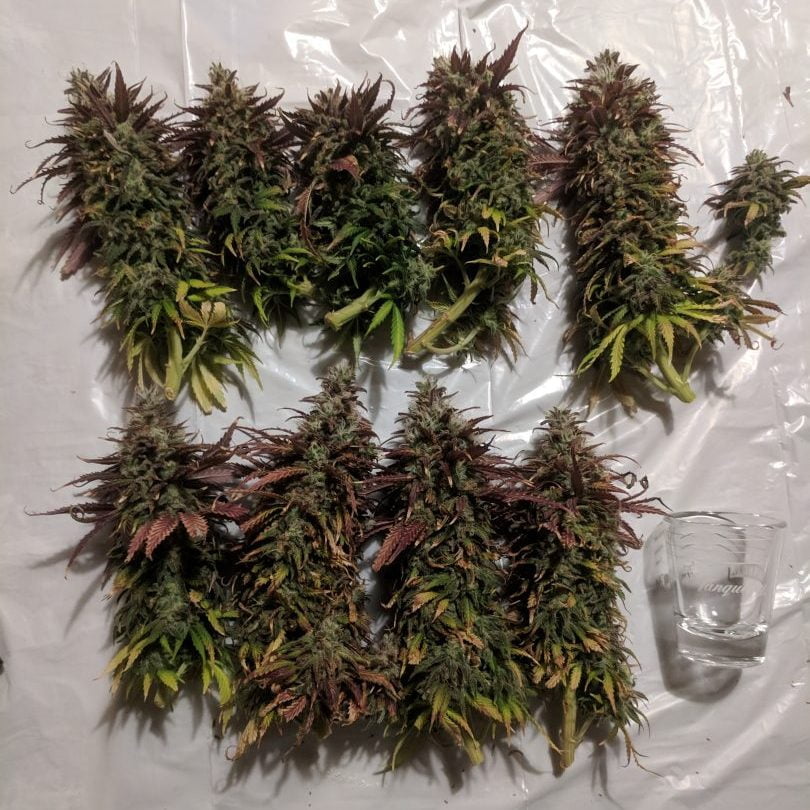
Learn to Grow Better Weed
Download our free guide to growing amazing cannabis at home.
Click Here For More Info
Is My Weed Ruined?
First of all, don’t worry – your harvest isn’t ruined. The hay/grass smell that your cannabis is giving off comes from chlorophyll. If you dry and cure your cannabis correctly, the chlorophyll breaks down and the smell goes away. If you dry your cannabis too fast, the chlorophyll won’t have time to break down fully. That isn’t ideal, but the smell will go away if you wait, and you can still enjoy your cannabis. How long it takes for the smell to disappear completely depends on how it was dried, but you shouldn’t have to wait longer than four weeks.
The Bad News
The good news is that your cannabis will be okay. The bad news is, at this point it will probably never be great. That’s because the same mistakes that gave your cannabis its unpleasant hay or grass smell have also probably destroyed some of the bud’s terpenes, and may have prevented the bud from reaching its maximum potency.
Why Does Weed Smell Like Weed?
Terpenes are strong-smelling natural compounds found in all kinds of plants. Cannabis has more than 100 different terpenes, and they are extremely important. Terpenes are what give different strains different scents, and they also interact with cannabinoids to modify the strain’s effects. Unfortunately, most of cannabis’ terpene content is stored in the trichomes, which are easily destroyed by touch and by temperature. Some terpenes can deteriorate at temperatures as low as 70°F – so it’s likely that if you dried your bud too quickly or too aggressively, a lot of the terpene content has been destroyed. The THC will still be there, but it might be a bland and generic high.
The high may also be less potent than desired. In a process called biosynthesis, cannabis converts certain compounds into others. For example, cannabis produces THC-A and later converts it to THC. This process can continue after you cut down your plant, if you dry your cannabis properly. If you dry it too quickly or expose it to temperatures that are too high, you can halt the process early and end up with less THC than you wanted.
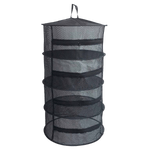
How to Dry and Cure Cannabis
Proper drying and curing are both extremely important factors in determining the final quality of your product, so it’s important to do them both right. Note that drying and curing are not synonymous – drying happens first, usually over the course of a week or ten days. Following drying, cannabis should be cured for a minimum of two or three weeks, although a longer cure time will yield smoother smoke. Here’s how to do it:
Drying
- Hang your trimmed branches from wire or string.
- The room your cannabis is stored in should be completely dark.
- Temperatures should stay between 60° and 70°F.
- Humidity should be kept at 45-55%.
- Keep a fan in the room to gently circulate air. Make sure it isn’t blowing directly across any of your bud, though. Be gentle with your trichomes!
- Check up on your bud every so often – when the smaller branches snap instead of bending and the flowers start to feel slightly crunchy, you’re ready to start curing.
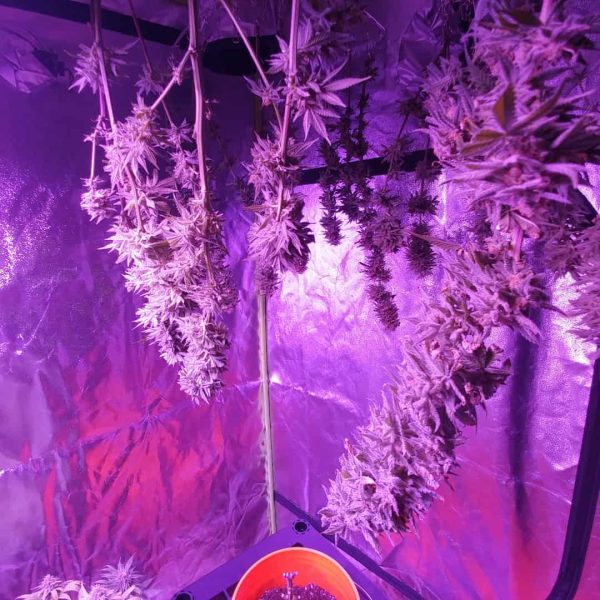
Curing
- If you haven’t already cut off your buds from their branches and manicured them, do that at this stage.
- Next, put all the trimmed buds in an airtight container. Mason jars are perfect, but you can really use anything as long as it is airtight. Fill the jar up loosely – don’t pack it tight.
- Store your filled containers in a cool, dry, dark location.
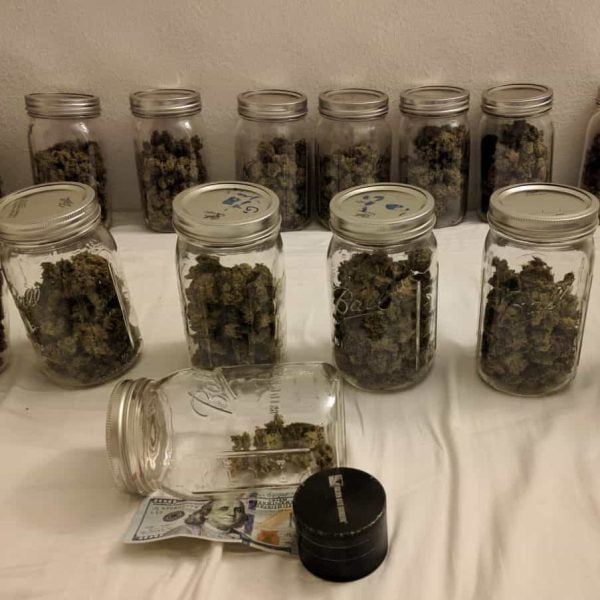
- Check on your buds several times per day. You should see that the buds aren’t crunchy on the outside anymore, but have rehydrated themselves. This is good! That moisture comes from deeper within the buds, and the curing process is how you get rid of it. If the buds aren’t rehydrating themselves, it means you dried your cannabis too much during the previous phase.
- For the first week, when you open the containers, leave them open for a few minutes to let the buds breathe. This allows the moisture to evaporate, and also allows new oxygen into the container. If you smell ammonia when opening a container, that means that the bud was still too wet after drying, and that anaerobic bacteria are currently eating your cannabis. This can lead to mold and rot.
- After the first week, continue to open the jars once per day to let the moisture evaporate.
After 2-3 weeks of curing, your cannabis will likely be cured to a point where it is pleasant to smoke, but try to be patient! As chlorophyll breaks down, it produces minerals and sugars that make the smoke feel harsher and more acidic. During the curing process, aerobic bacteria and enzymes break down those compounds, which makes the bud feel a lot smoother. If you can wait eight weeks, your bud will taste and feel amazing.
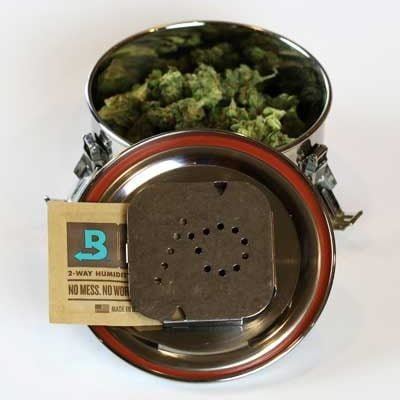
If you want to make the curing process a little bit easier you could use a storage container like CVault and two-way humidity packs from Boveda.
CVault containers (available here in our store) are air-tight and lightproof. They’re made from stainless steel and will last you a lifetime. Boveda first started by making humidity devices for cigars and humidors so they naturally work great with weed.
One Boveda pack (available here in our store) can keep your weed fresh for up to 4 months and then be replaced.
If you want to learn even more about growing good cannabis, we offer a free 40+ page guide full of images.
Now available on Amazon.
Sign up for our newsletter and download the digital copy today!
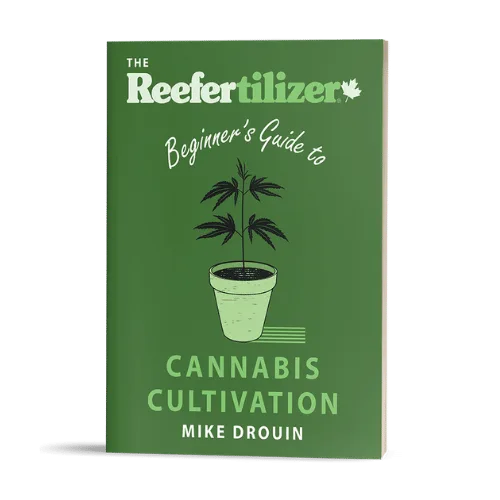
This guide will answer many questions about growing cannabis, like the following...
Selecting Seeds
Identify and Correct Problems
Maximize Yield
Much More...
Get a Chance to INSTANTLY WIN a Reefertilizer Nutrient Kit When You Sign Up.
Elijah Petty is a writer in the cannabis industry. He aims to use his platform to help educate people about cannabis and dispel some of the myths and misinformation that surround the plant.

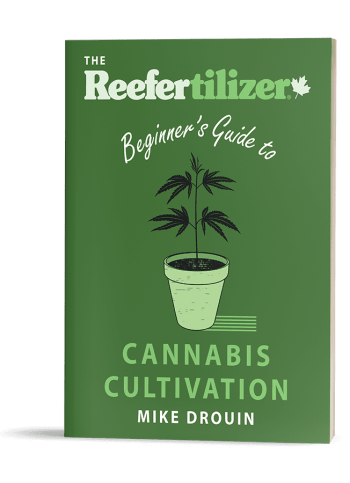
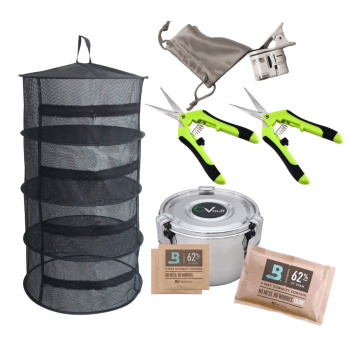
Comments are closed.